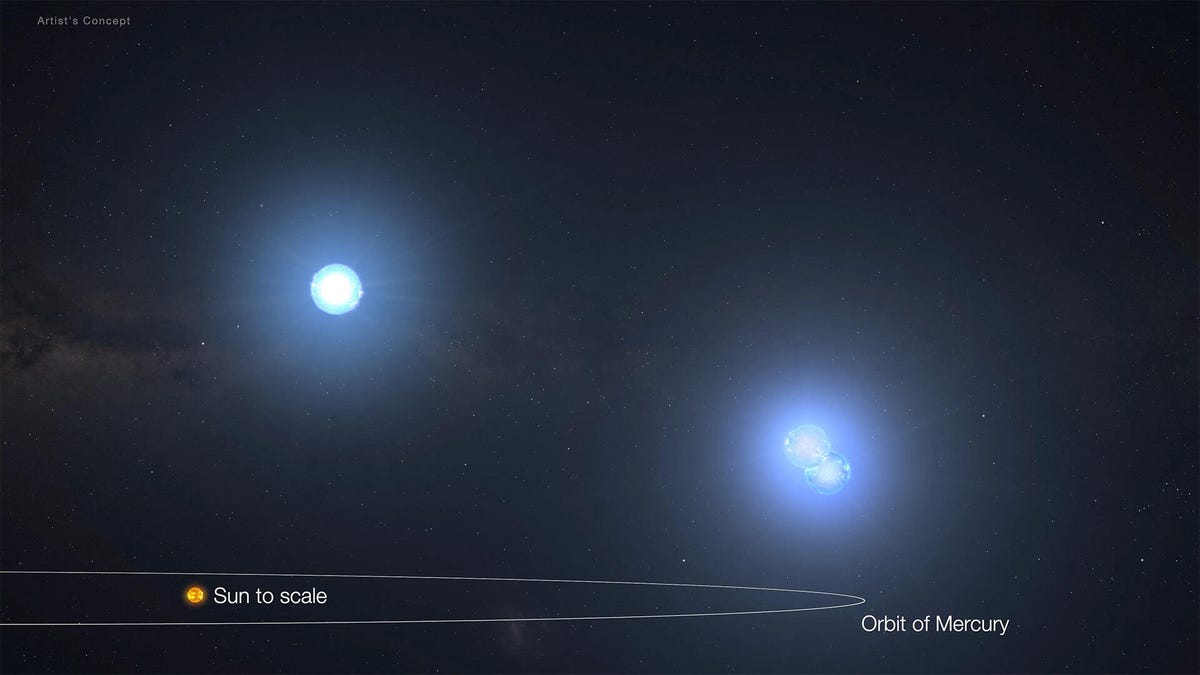NASA teams up with AI to discover a record-breaking stellar trio


The universe is full of oddities and formations that range from magnetars to four-star solar systems. One such oddity is the stellar trio, where two stars orbit each other and then a third star orbits the other two. A group of professional and amateur astronomers used NASA’s TESS satellite and AI to find a stellar trio unlike any other star observed to date.

The trio of stars, catchily named TIC 290061484, is special because its orbits are extremely fast. Two of the stars orbit each other every 1.8 days, while the third member of the trio orbits the other two every 24.5 days. For reference, Earth orbits the sun every 365 days and Mercury orbits the sun every 88 days. The sun completes its orbit around the center of the Milky Way galaxy once every 225 million Earth years.
Read more: Get outside and catch a meteor shower: Here are all the ones left in 2024
According to The Astrophysical JournalThe fastest stellar trio previously observed involved an outer star that orbited its duo in 33.02 days. That makes TIC 2900061484 the fastest trio of stars ever observed by humans.
The trio was discovered by astronomers using NASA’s TESS satellite, along with AI. Initially, the satellite observed flickers of starlight. Because the system is flat from TESS, the star with the longer orbit would overshadow the two smaller stars, causing the flickers. Astronomers used machine learning to sift through large sets of starlight data to identify when the eclipses occurred, and a smaller team of civilian astronomers further filtered the data to find the trio.
Read more: October 2024 Sky-gazing stars include a Supermoon and a rare comet
NASA uploaded a video of TESS observing the stellar triplets on YouTube. As the stars revolve around each other, one passes in front of the other. Creating an eclipse event can help astronomers identify a duo or trio of stars in a planar plane. Interestingly, from 1:05 to 1:15 in the video, you can see all three stars eclipsing each other as their orbits take them around. That’s the kind of information astronomers were looking for when filtering the data.
“The system’s compact, edge-on configuration allows us to measure the orbits, masses, sizes and temperatures of its stars,” said Veselin Kostov, research scientist at NASA’s Goddard Space Flight Center in Greenbelt, Maryland, and the SETI Institute in Mountain View, California, in a statement. “And we can study how the system is formed and predict how it might evolve.”
Although it is unusual to see a trio of stars with such small orbits (all three orbit each other in a space smaller than Mercury’s orbit around the Sun), the orbit appears to be stable. All three stars orbit in a flat plane, indicating that their gravity does not disturb the orbits of the other stars. For now, all three stars should continue orbiting each other forever.
But as the stars get older, the fireworks begin.
Read more: Look out for the Northern Lights to put on a dazzling show this week
‘As the inner stars age, they will expand and eventually merge, causing a supernova explosion around 20 years from now [million] up to 40 million years,” says NASA.
Currently, this trio has the shortest orbit of all observed trios, but that may not last long. NASA’s Nancy Grace Roman Space Telescope captures more detailed images than TESS, allowing astronomers to look deeper into the Milky Way galaxy with greater clarity. This could reveal previously undiscovered trios with even shorter orbits.
“We don’t know much about many of the stars at the center of the Milky Way, except the brightest ones,” said Brian Powell, co-author of the study and data scientist at Goddard. “Roman’s high resolution will help us measure the light from stars that usually blur together, giving us the best look yet at the nature of galaxies in our Milky Way.”




